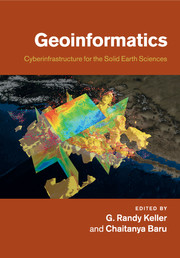Book contents
- Frontmatter
- Contents
- List of contributors
- Preface
- Introduction
- Part I Case studies from other disciplines
- Part II Modeling software and community codes
- 5 Development, verification, and maintenance of computational software in geodynamics
- 6 Parallel finite element modeling of multi-timescale faulting and lithospheric deformation in western USA
- 7 Next-generation plate-tectonic reconstructions using GPlates
- Part III Visualization and data representation
- Part IV Knowledge management and data integration
- Part V Web services and scientific workflows
- Part VI Emerging international and other efforts
- Index
- Plate section
- References
6 - Parallel finite element modeling of multi-timescale faulting and lithospheric deformation in western USA
from Part II - Modeling software and community codes
Published online by Cambridge University Press: 25 October 2011
- Frontmatter
- Contents
- List of contributors
- Preface
- Introduction
- Part I Case studies from other disciplines
- Part II Modeling software and community codes
- 5 Development, verification, and maintenance of computational software in geodynamics
- 6 Parallel finite element modeling of multi-timescale faulting and lithospheric deformation in western USA
- 7 Next-generation plate-tectonic reconstructions using GPlates
- Part III Visualization and data representation
- Part IV Knowledge management and data integration
- Part V Web services and scientific workflows
- Part VI Emerging international and other efforts
- Index
- Plate section
- References
Summary
Introduction
The lithosphere, which includes the crust and the uppermost part of the mantle, is the mechanically strong outer shell of the Earth. The lithosphere is broken into a dozen or so pieces, called the tectonic plates. Constant motions between these tectonic plates cause lithospheric deformation, which leads to mountain building, earthquakes, and many other geological processes, including geohazards. Hence understanding lithospheric deformation has been a major focus of modern geosciences research.
Most studies of lithospheric dynamics are based on continents, where the lithosphere is relatively soft and hence deforms strongly, and where direct observation is relatively easy. One major observational technique developed in the past decades is space-based geodesy (e.g., Gordon and Stein, 1992; Minster and Jordan, 1987). The Global Positioning System (GPS), the Interferometric Synthetic Aperture Radar (InSAR), and other space-based geodetic measurements are providing unprecedented details of deformation at the Earth's surface, thus revolutionizing the studies of lithospheric dynamics.
As space geodetic data grew rapidly in recent years, it has become increasingly clear that interpreting the tectonic implications of these data may not be straightforward. In many places, space-geodetic measurements of crustal deformation differ significantly from that reflected in geological records (Dixon et al., 2003; Friedrich et al., 2003; He et al., 2003; Liu et al., 2000; Pollitz, 2003; Shen et al., 1999). This could be due to many factors; an important one is timescale-dependent lithospheric rheology and deformation (Jeanloz and Morris, 1986; Liu et al., 2000; Pollitz, 1997, 2003; Ranalli, 1995).
- Type
- Chapter
- Information
- GeoinformaticsCyberinfrastructure for the Solid Earth Sciences, pp. 68 - 94Publisher: Cambridge University PressPrint publication year: 2011



